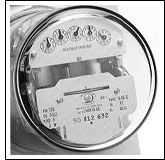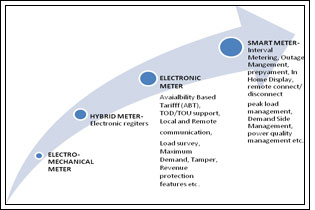 Sunil Singhvi, Chairman—Meter Division, IEEMA
Sunil Singhvi, Chairman—Meter Division, IEEMA
In electricity generation, transmission and distribution, energy metering plays a vital role for accurate and precise measurement of electricity. Like any other commodity, energy is being measured and monitored for more than 100 years and many new technologies have evolved to derive more benefit from metering systems.
Initially electro-mechanical meters came into market in year 1890s and were based on principle of induction disc, whose rotation speed was made proportional to the power in the circuit followed by number of revolution proportional to energy usage. Electromechanical meters were robust in design, but lacked in recording other electrical parameters like load, voltage, current, power factor and were unable to support flexible tariffs/detect theft.
Electronic energy meters were introduced in year 1980s which were having electronic registers mounted on induction-type and named as hybrid meters. These meters started providing support for electronic read. Then in 1990s fully electronic static meter’s were introduced, these meters records information about various electrical parameters like voltage, current, power factor and energy for analysis and billing purpose respectively. The basic operating principle of electronic meter is based on sampling of voltage, current with respect to time and derives necessary information out of these like energy, demand etc.
However in case of India revenue protection features came into existence and were very much in demand by utilities. Such kinds of meters are capable of providing revenue protection features by using smart sensors and storing it in to the meter memory with date & time stamp.
These meters are also having time-of-day/time-of-use based tariff support along with communication capabilities so that these could be read locally or remotely by relevant communication devices so that the meter reading data could be analyzed and proper billing could be done at central station by utility.
Further to this, in case of interface points between generation & transmission, the frequency linked tariffs were introduced to bring grid discipline, hence availability based tariff (ABT) came to existence. These meters are still in very much demand by utilities as they provide required electrical parameter for 15 minute frozen value which further help utility to calculate Unscheduled Interchange charges.

Government of India gave special emphasis on distribution transformer metering. To make installation simple special kind of meters, which have inbuilt current transformer were introduced and power cable can directly pass thread-through arrangement provided in meter. These meters are also equipped with built-in communication system. These meters record phase-wise electrical parameters for load flow analysis calculations and estimations.
There is serious concern regarding commercial losses of utilities. Beside this in many countries meter reading costs are very high. Hence, to cater the above said issues new metering technology i.e. prepayment meter was introduced. These meters are having built-in switch, which gets opened after giving proper alarm to consumer once the credit gets exhausted or in case of violation of sanction load. This was starting of new metering era, in which meters were not only measuring but were also managing load. This metering technology became very popular in African and European countries; subsequently the same got introduced in India as well in the year 2005.
Presently in India more than 100,000 consumers are using prepayment meters across various utilities and also very much prevalent in real estate. These meters help consumers and utilities in budgeting, energy conservation and upfront collection of revenue respectively. This metering technology also provides load / demand management, reduction in bad debts, energy efficient, etc.
Prepaid meter started with coin-based recharge technology and later with magnetic card and smart card. But all such mechanism required physical devices to be present at meter and at vending station, also consumer was supposed to carry coin or card at vending station for recharging their meters. Later keypad based technology similar to our mobile phone keypads was introduced which became very popular and widely accepted by utilities across the globe. As in keypad the convenience to utility is that the vending option is not limited to their counters / office rather consumer can buy electricity from anywhere and anytime by using any electronic media such as utility website, Interactive voice response, Point of Sale terminals, SMS, etc. Utilities are keen to move more customers to prepayment as the costs of billing and revenue collection is much lower than post-paid customers.

Now many developed countries are thinking on reduction in carbon footprints, actual meter read, participation in demand-side management, micro-generation etc and these concerns are become main drivers for introduction of smart metering worldwide. This trend came due to evolution of smart grid in which two ways information flow in between generations, transmission, distribution and consumer is required. As this will help in managing supply and demand gap and shall also help in planning, managing and controlling peak and off peak demand.
Smart meters are not only providing metrology parameters, they also have connect/disconnect mechanism along with remote communications. These meters can communicate with backend system and at the same time provide all information on in-home display for better management of electricity and consumer can also take part in demand side management. It will encourage them to use cheaper energy during off peak hours. In order to design scalable smart metering system, these meters are provided with integrated communications modules which provide connectivity up to concentrator for group of meters. Smart meters basically contains communication module and built in switch. Using these smart meters utility can provide near real time information to consumers along with alarms and similarly consumer can also provide near real time information to utility. We can say that now metering technology is integrated with IT and communication, which makes it beyond metering and then journey of changing technology, is moving on.
Various communications technology like power line communication, Mesh radio, GPRS, 3G etc. are implemented worldwide but the selection of technology varies from country power system infrastructure, consumer vicinity, availability of resources and supplier driving factors.
India is also planning trials of smart meters. In Indian context cost-benefit analysis of smart meter has to be done critically.